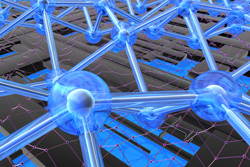Project Success Stories - Big steps in the nano-world revolutionise new products
Electronic devices are getting smaller but their power, speed and functionality is getting bigger. And with progress in nano-electronics come substantial new opportunities to develop more powerful microchips at smaller and smaller scales - a nanometre, or nm, is a billionth of a metre - and at a price that remains attractive for industry and for the end-user. Aware of this challenge, the European Commission gathered key players in the field - scientists from industry, research institutes and universities - to work together on advanced processes with the aim of developing ever-smaller microchip technology, 32 nm and below. But the laws of physics have not made this task an easy one. Moore's law - named after Intel's co-founder Gordon Moore - states that the number of transistors in a microchip doubles every two years. Computer scientists are reaching beyond that limit by packing more functions onto a single chip. And European researchers are at the cutting-edge of the complementary metal-oxide-semiconductor (CMOS) technologies underscoring this progress. Beyond physical limits In 2004, the EU kicked off its campaign to take a lead in CMOS by funding an integrated project, called Nanocmos, which acted as a platform for knowledge and expertise development. By working together, the participants created a vibrant, united research community in Europe necessary to develop the 45 nm, 32 nm and smaller CMOS technologies. The encouraging results of Nanocmos prompted the EU to pursue its efforts and fund the Pullnano project. Uniting those involved in Nanocmos with around 15 new academic partners, Pullnano continued to advance knowledge in this challenging field. As a result of the project, 45 nm and 32 nm CMOS technologies were rolled out, allowing European integrated circuit manufacturers to consolidate their position in the global microelectronics market. Both the 45 nm and 32 nm CMOS technologies have been taken up by the Eureka nano-electronics clusters. They developed a project, entitled Foremost, which successfully finalised work on an industrial version of the 45 nm technology in mid-2009. This technology is now used in production by the leading European chip manufacturer STMicroelectronics. The results accomplished by Pullnano are today underpinning important innovation which is taking place in Europe's R&D sector, leading to products and services in a range of applications, from communications and consumer products to embedded electronics in industrial applications. For example, the applications being developed are used in new generations of i-phones, televisions, videos and audio systems, and a raft of mobile devices and portable computers. The Nanocmos and Pullnano projects have helped European chip manufacturers to maintain their strong contribution to the worldwide microelectronics industry and paved the way for new challenging system-on-chip designs and their successful introduction to the market. The technologies developed by these successive projects are also now being used in a series of more application-oriented projects focusing on such challenges as energy efficiency, CO2-reduction and electric cars. Thanks to some far-sighted research funding policy, the Commission has helped European industry gain a valuable lead in a fast-moving and vital enabling technology. The results of which can be seen in the small but powerful electronic devices that help us in our daily lives, at work, on the road and in our homes.



